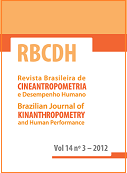Maximal lactate steady state estimated by different methods of anaerobic threshold
DOI:
https://doi.org/10.1590/1980-0037.2012v14n3p264Abstract
The aim of this study was to compare anaerobic threshold (AT) as determined by four different methods with maximal lactate steady state (MLSS) in endurance runners. Nine moderately trained runners performed the following tests on different days: a maximal incremental exercise test to determine maximal oxygen uptake (VO2max), velocity at VO-2max (vVO2max), and blood lactate response; and two to five 30-min constant load tests to determine MLSS. Based on the incremental test, four methods of AT determination were used: AT1 – velocity at 3.5 mmol.L-1 blood lactate; AT2 – velocity corresponding to the minimum lactate-velocity equivalent plus 1.5 mmol.L-1; AT3 – velocity at Dmax; and AT4 – velocity before the second consecutive blood lactate increase greater than 0.5 mmol.L-1. There were no significant differences between MLSS and AT as determined by four different methods. However, the Bland-Altman analysis showed the extent of disagreement between variables when the subjects were analyzed individually. MLSS was significantly correlated with AT1 (r=0.68; p=0.04) and AT2 (r=0.79; p=0.01). Thus, although no significant differences were found between AT methods and MLSS, one should be cautious about using these methods interchangeably.



